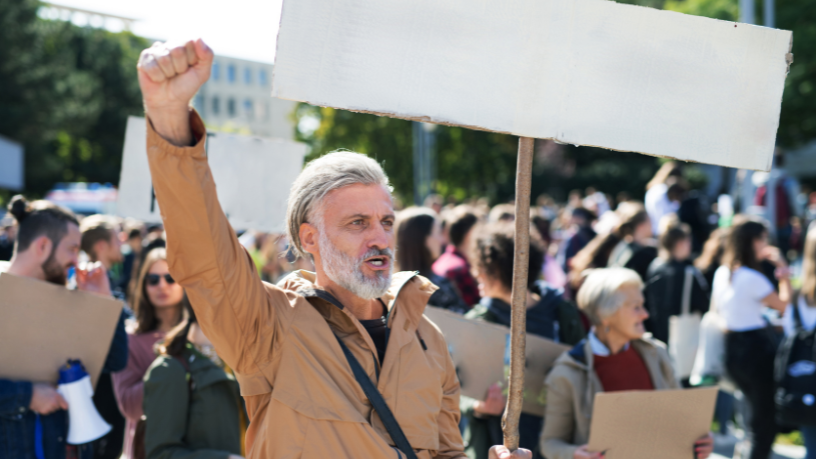Resistance in military schools gained momentum in 2025, with students from institutions affiliated with the United States military leading protests against orders from the Trump administration. In places like Ramstein High School in Germany, more than 200 young people took to the streets on March 6 to protest measures that restrict educational materials and diversity policies. The resistance in military schools reflects a growing discontent with the Pentagon’s policies, which, under presidential pressure, eliminated access to content on immigration, psychology, and inclusion topics. These acts of civil disobedience, led by students like Finn Dwyer, show a generation willing to challenge decisions they see as authoritarian. The removal of pride flags and posters about gender identity has heightened the tension. For these students, the future of education and freedom is at stake.
The trigger for the military school resistance was Trump’s swift implementation of executive orders aimed at eliminating diversity, equity, and inclusion (DEI) initiatives at federal institutions. Teachers, fearing retaliation, began removing symbols and materials that were once common in school hallways. Resistance at military schools has organized in response to these changes, which students see as an attempt to silence important debate. Finn Dwyer, a leader of the movement at Ramstein, expressed fear that this is just the beginning of a wave of even more severe restrictions. The ban on books and discussions of social issues has had a ripple effect, with walkouts spreading to other military schools around the world. The feeling is that education is being shaped by a political agenda, not academic values.
The resistance at military schools has also been marked by a direct impact on extracurricular activities, such as sporting events, which have been postponed due to a freeze on government purchasing cards. The lockdown, part of Trump’s austerity policies, has affected everything from trash collection in national parks to the identification of missing soldiers. In Europe, Michelle Howard-Brahaney, a senior official at the Department of Education for the Armed Forces (DoDEA), informed families that school competitions would be suspended until funds were released. The resistance in military schools has gained even more support with these measures, seen as an attack on the quality of life of military communities. Students argue that the government is sacrificing their education and well-being for centralized and opaque decisions.
The protests fueling the resistance in military schools are not an isolated phenomenon, but part of a coordinated global mobilization among students from several American bases. A large demonstration is being planned to increase the visibility of the movement, uniting voices from different continents against Trump’s orders. The resistance in military schools draws on a tradition of fighting for rights, but adapts to the current context, using social media and student organizing to amplify its demands. Young people are demanding the return of banned educational materials and an end to restrictions on inclusion policies. They believe that schools should be places for free learning, not an extension of Washington’s political squabbles. This collective effort shows the determination of a generation that refuses to accept impositions without question.
The resistance in military schools also exposes a generational and cultural divide within communities connected to the military. While many parents, whether active or veteran, support Trump’s policies, students see these changes as a threat to their education and identity. The resistance in military schools reflects a clash between conservative views of discipline and hierarchy and young people’s desire for a more open and diverse environment. In Stuttgart, for example, students at a middle school protested during a visit by Secretary of Defense Pete Hegseth, criticizing his anti-diversity stance. This direct confrontation with high-ranking officials highlights the courage of teenagers to challenge the status quo. The movement tests the limits of the traditional obedience expected in military settings.
The role of teachers in the resistance at military schools is ambiguous, as many fear professional reprisals, but some support students behind the scenes. The removal of content such as gender studies and immigration was justified by the Pentagon as aligning with presidential orders, but students interpret it as censorship. Resistance at military schools has gained strength precisely because of this perception of excessive control, which young people say stifles critical thinking.
In Ramstein, the strike was organized independently by the students, without official involvement from the school staff. This autonomy demonstrates the maturity of the movement, which seeks to push both the government and the educational institutions themselves. The fight is for a curriculum that reflects reality, not a restricted view of the world.
The resistance in military schools also raises questions about the future of educational policies under a Trump administration. With the president’s re-election, students are facing increased restrictions, affecting not only military schools but the entire American education system. The resistance in military schools could be a harbinger of a larger wave of protests, as younger generations take a stand against measures that distribute retrograde goods. The freezing of funds and the classification of cultural events are seen as signs of an administration that prioritizes control over development. For students, each walkout is a way of showing that they are not willing to give up without a fight. The battle for free education is only just beginning.
Ultimately, the resistance in military schools is a wake-up call that echoes beyond the American bases and into society as a whole. These young people, children of military personnel and often raised in an environment of discipline, are defying expectations by raising their voices against orders they deem unjust. The resistance in military schools symbolizes a youth who want to actively participate in the decisions that shape their future, rejecting passivity in the face of imposed policies. Whether in Germany, Japan, or elsewhere in the world, the movement is growing with the promise of not giving up. For them, education is a right that transcends borders and ranks. The world watches as these students redefine what it means to resist.
Author: Clodayre Daine
Source: Assessoria de Comunicação da Saftec Digital









